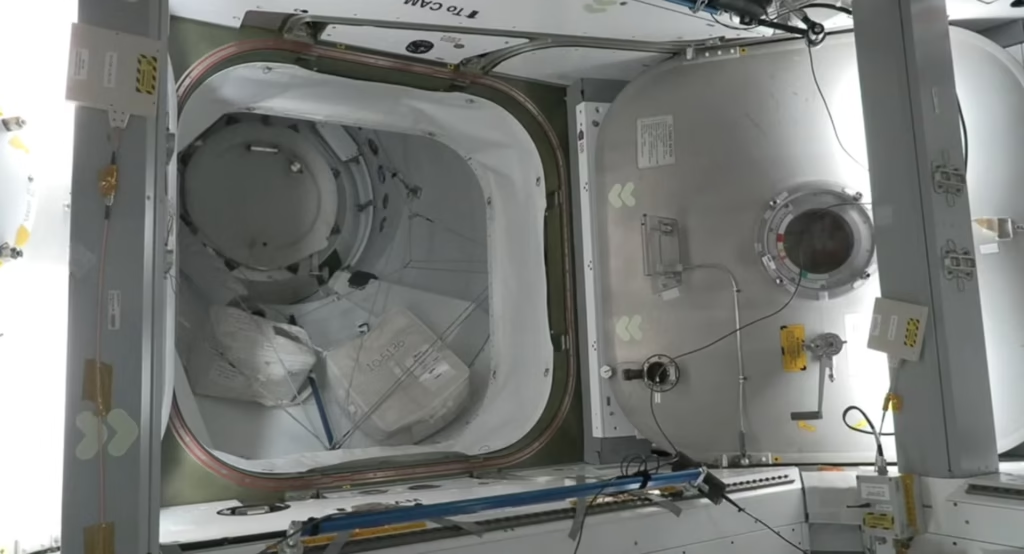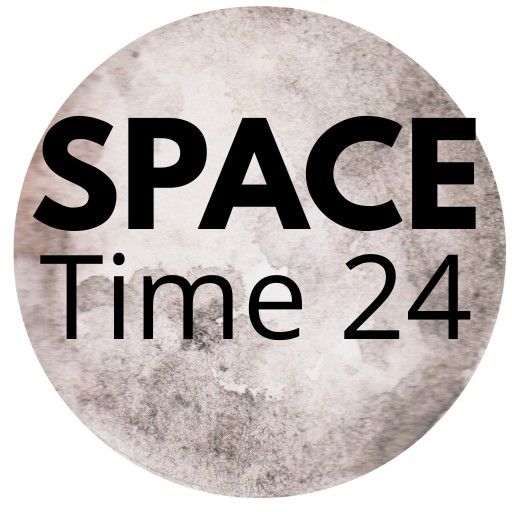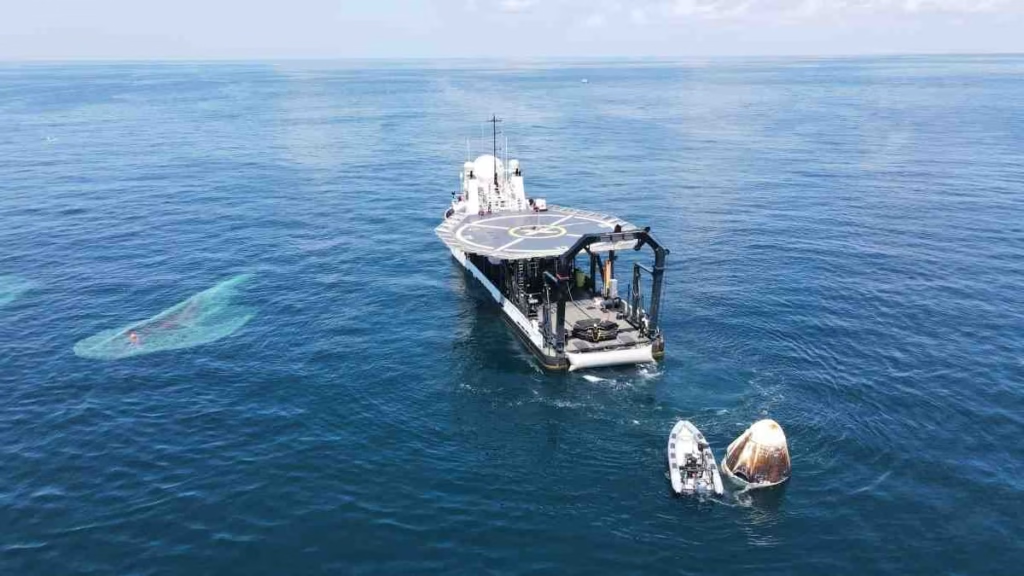Axiom Mission 4 Crew Successfully Arrives at the ISS- Axiom Mission 4 crew, including Indian astronaut Shubhanshu Shukla, has arrived safely at the ISS. Read full details about the docking, crew, and what’s next.

Axiom Mission 4 Crew Successfully Arrives at the ISS: Started Orbiting
The historic Axiom Mission 4 (Ax-4) has officially begun its in-orbit phase following a successful docking with the International Space Station (ISS). This mission marks another significant chapter in commercial spaceflight, as well as a proud moment for India and the global space community with Shubhanshu Shukla, a key member of the Ax-4 crew, making his arrival aboard the ISS.
This article provides a complete overview of the Ax-4 mission’s arrival, the docking process, crew composition, international collaboration, and what lies ahead for the astronauts aboard the ISS.
Axiom Mission 4 Crew Successfully Arrives at the ISS: A New Era of Space Missions
Axiom Space, in collaboration with NASA and SpaceX, launched the Axiom Mission 4—the fourth all-private astronaut mission to the ISS. It represents the growing role of commercial space companies and international astronauts in expanding the reach of human space exploration.
Axiom Mission 4 Crew Successfully Arrives at the ISS with a seamless docking completed and the crew now aboard the orbital laboratory, Ax-4 is set to carry out a range of scientific, educational, and outreach activities. The mission’s crew includes space veterans and first-time astronauts representing multiple nations, highlighting the truly global nature of modern spaceflight.
Axiom Mission 4 Crew Successfully Arrives at the ISS: Meet the Ax-4 Crew
1. Peggy Whitson (Commander)
A former NASA astronaut and the most experienced U.S. astronaut in history, Peggy Whitson leads Ax-4. With hundreds of days in space under her belt, she brings invaluable expertise to the team.
2. Shubhanshu “Shux” Shukla (Pilot)
Shubhanshu Shukla, an Indian astronaut participating in his first space mission, represents the growing involvement of India in international commercial spaceflight. His presence aboard Ax-4 is a moment of pride for the Indian space community and inspires future space professionals from the region.
3. Walter “Suave” Villadei (Mission Specialist)
An Italian Air Force colonel and spaceflight engineer, Walter Villadei brings advanced systems knowledge and technical precision to the crew. His training includes experience with multiple space agencies.
4. Tibor Kapu (Mission Specialist)
Representing Hungary, Tibor Kapu contributes to Ax-4’s scientific portfolio. His role includes conducting experiments and contributing to educational outreach during the mission.
Axiom Mission 4 Crew Successfully Arrives at the ISS: The Journey to the ISS
The Ax-4 crew launched aboard a SpaceX Falcon 9 rocket from NASA’s Kennedy Space Center in Florida. Their spacecraft, the Crew Dragon, performed a series of orbital maneuvers to gradually align its trajectory with the ISS. The approach followed a carefully choreographed flight plan, ensuring a precise and safe rendezvous.
As the spacecraft neared the station, mission control and onboard systems monitored alignment, velocity, and distance. The final docking was executed automatically but closely supervised by teams on Earth and aboard the ISS.
The Docking and Hatch Opening
Axiom Mission 4 Crew Successfully Arrives at the ISS and docked successfully with the Harmony module of the International Space Station. The moment marked the official beginning of the crew’s orbital stay.
After pressurization checks were completed and safety protocols observed, the hatch was opened. Members of the ISS crew warmly welcomed their new colleagues, symbolizing the unity of the global space community.
Among the team on the ISS who assisted in the docking and hatch procedures was an American astronaut who also shared his personal experience of monitoring the Ax-4 approach and noted how the crew’s spacecraft came into view from below—a visually stunning and technically challenging maneuver.
The Orbital Approach: R-Bar Pathway
Axiom Mission 4 Crew Successfully Arrives at the ISS the Ax-4 spacecraft approached the ISS from below, a method known as the R-Bar (radial) approach. This trajectory takes advantage of Earth’s gravity to naturally reduce the spacecraft’s speed, allowing for a more fuel-efficient and stable docking.
Approaching from below also provides astronauts on the ISS a clear view of the incoming spacecraft, which allowed crew members to capture photographs and visuals of Ax-4 as it aligned with the station. These photos are valuable both for documentation and public outreach, bringing audiences closer to the excitement of space operations.
https://x.com/esaspaceflight/status/1938206841600635270?t=7vlHnPEeNPkkO0F2W7kw1g&s=19
International Collaboration in Action
The Ax-4 mission is a prime example of how commercial spaceflight is becoming a platform for global participation. While Axiom Space leads the mission and SpaceX provides launch capabilities, agencies like NASA, ESA (European Space Agency), and others provide support for mission operations, crew training, and science planning.
Shubhanshu Shukla’s involvement is especially meaningful for India, marking a breakthrough moment for its presence in international commercial space missions. Though the mission was not launched by ISRO, the Indian Space Research Organisation, Shukla’s participation contributes directly to India’s future space ambitions by building human spaceflight experience.
What Happens After Docking?
Now that the Ax-4 crew is safely aboard the International Space Station, their mission schedule begins immediately. Here’s what lies ahead:
1. Science Experiments
The crew will conduct microgravity experiments in areas such as biology, materials science, and space medicine. Some of these experiments are developed in partnership with universities, private labs, and international agencies.
2. Educational Outreach
One of the goals of Axiom missions is to inspire future generations. Crew members will host virtual sessions with schools, conduct live demonstrations, and share their experiences from orbit.
3. Technology Demonstration
The Ax-4 team will also test new equipment and protocols in preparation for Axiom Station, a future commercial space station under development.
4. Cultural Contributions
In addition to science and tech, astronauts often bring cultural symbols, books, or art to space. These items help represent their countries and cultures and may be used in public engagement after the mission.
Shubhanshu Shukla’s Role in the Mission
As a mission specialist, Shubhanshu Shukla’s duties include supporting research experiments, maintaining station systems, and participating in media or educational activities. His training covered:
- Space station systems
- Zero-gravity operations
- Emergency procedures
- Science payload management
His inclusion in the crew reflects not only his qualifications but also the shift toward international diversity in crew selection, especially from emerging space nations.
Reactions from Around the World
The successful arrival of the Ax-4 crew grand welcome by Expedition 73 (Crew-7) and has been met with praise from government officials, scientists, and the general public. Social media is filled with congratulations from Indian citizens, space enthusiasts, and educational organizations celebrating Shukla’s historic role.
Photos of the Ax-4 capsule approaching the ISS have gone viral, showing the spacecraft silhouetted against Earth as it ascends toward humanity’s orbital outpost. These moments continue to inspire millions.
Mission Duration and Return Plans
The Ax-4 mission is scheduled to last approximately 14 days, although this timeline can be adjusted depending on mission conditions, weather at splashdown sites, and experiment completion.
At the end of the mission, the Crew Dragon capsule will undock from the ISS, perform a deorbit burn, and reenter Earth’s atmosphere. The splashdown is expected to occur in either the Pacific Ocean or Atlantic Ocean, depending on conditions, where SpaceX recovery ships will retrieve the crew.
A New Path for Indian Participation in Space
Shubhanshu Shukla’s presence on Ax-4 paves the way for future Indian astronauts to participate in international missions. It complements India’s planned human spaceflight project, Gaganyaan, and contributes valuable experience to India’s growing space sector.
His mission also sends a strong message to Indian youth: with the right training, education, and international cooperation, they too can reach for the stars.
Axiom Mission 4 Crew Successfully Arrives at the ISS: Final Thoughts
Axiom Mission 4 Crew Successfully Arrives at the ISS marks another milestone in the evolution of human spaceflight. With astronauts like Shubhanshu Shukla, Peggy Whitson, Walter Villadei, and Tibor Kapu aboard, the mission is rich with diversity, science, and international collaboration.
As the team begins its work in orbit, they carry with them not just experiments and equipment, but the hopes and dreams of billions of people across the globe.
Their successful docking, hatch opening, and entry into the ISS confirm that commercial spaceflight is no longer just a concept—it is a working reality. And as we watch them orbit 400 kilometers above Earth, one thing is clear: the future of space exploration belongs to the world, and the world is now onboard.

